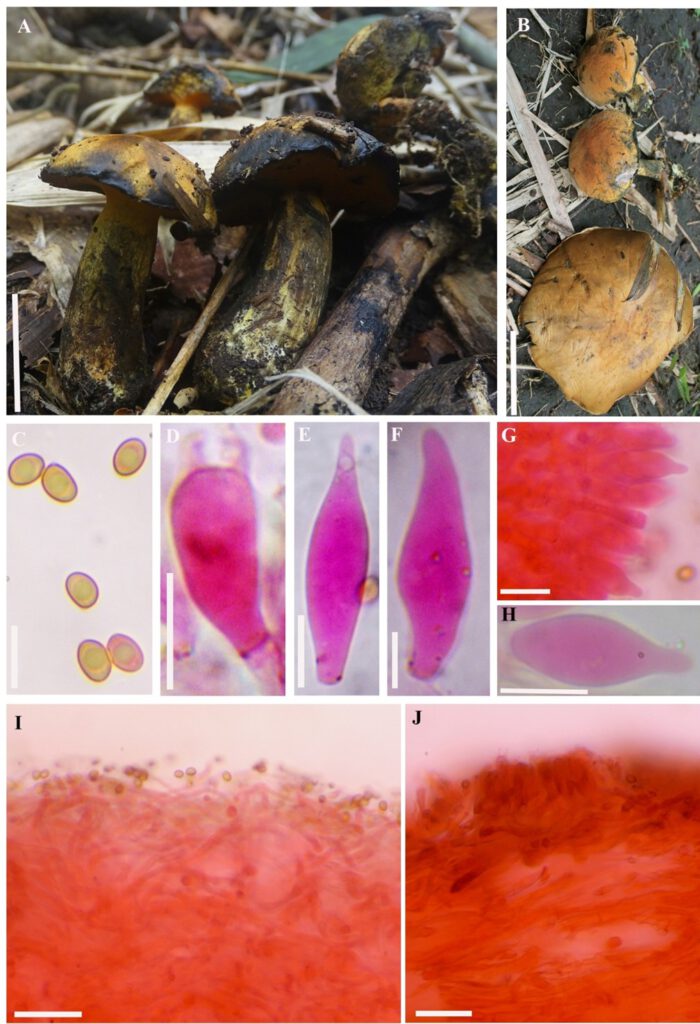Buchwaldoboletus xylophilus (Petch) Both & B. Ortiz, Bull. Buffalo Soc. nat. Sci. 40: 3 (2011)
MycoBank number: MB 545884; Index Fungorum number: IF 545884; Facesoffungi number: FoF 11793;
Synonymy:
Boletus xylophilus Petch, Ann. R. bot. Gdns Peradeniya 7(4): 283 (1922)
Gyrodon xylophilus (Petch) Heinem. & Rammeloo, Bull. Jard. Bot. natn. Belg. 53(1/2): 295 (1983)
Pulveroboletus xylophilus (Petch) Singer, in Singer, Araujo & Ivory, Beih. Nova Hedwigia 77: 98 (1983)
Description
Basidiomata medium to large sized. Pileus 6 – 10 cm in diam., convex to applante; surface golden yellow to grayish orange, subtomntose, dry. Context light yellow to yellow, up to 3 cm thick in mature specimens, staining light blue to bluish black on touch or bruising. Hymenophore adnate to slightly decurrent; pores and tubes concolourous, pale yellow, yellow or olive yellow, staining dark blue when cut or bruised; pores small, 2 – 3/mm, oblong, nearly radially arranged; tubes 6 – 12 mm long. Stipe 3.5 – 6 cm x 0.6 – 1 cm, central, subcylindrical, broader to bottom, surface yellowish to olive yellow or brownish yellow, nearly glabrous; context concolourous with that of pileus, tinged with brownish yellow colour, staining bluish when cut; basal mycelium pale yellow to bright yellow.
Basidiospores 4.5 – 5.5 x 3 – 3.5 μm, globose to subglobose, thin walled, with one guttule normally, pale yellow in water. Basidia 13 – 18 x 5 – 7 μm, clavate, 4- spored, thin walled, hyaline; sterigmata up to 4.5 μm long. Hymenophoral trama boletoid; hypahe 2.5 – 10 μm wide, thin walled. Pleuropcystidia 17 – 48 x 6 – 11 μm, scattered, fusoid ventricose with long beak, thin walled, hyaline. Cheilocystidia 17 – 30 x 4 – 6.5 μm, numerous, fusoid with long beak in many, clavate with acute tip in some, thin walled, hyaline. Pileipellis a trichoderm of interwoven hypahe, 100 – 205 μm thick; outer pellis consist of 2.5 – 5 μm wide frequently septate hyphae arranged as interwoven; inner layer composed of interwoven thin walled, loosely packed filamentous hyphae, 3 – 6 μm wide. Pileal trama parallel to interwoven, hyphae 4 -15 μm wide, thin walled. Stipitipellis a cutis interrupted by caulohymenium; caulobasidia same as hymenial basidia in size and shape. Stipe trama parallel to interwoven; hypahe 3 – 8 μm wide, thin walled, hyaline. Caulocystidia 15 – 25 x 4 – 7 μm, clavate to broadly clavate, thin walled, pale yellow.
Material examined: Solitary to scattered on soil, under bamboo plants, in tropical evergreen forest in Palode, Thiruvananthapuram district, Kerala State, India, 24 September 2021, Salna N., ZGCSN110.Distribution: Reported from Sri Lanka, Malaysia, Hong Kong, China and Philippines (Corner 1972, Pegler 1986, Ortiz-Santana & Both 2011, Xie et al. 2021).
Sequence data: GenBank accession no ITS: ON707263(ITS1)
Notes: Buchwaldoboletus xylophilus is one of the rare non-ectomycorrhizal bolete. The species is widely reported in tropical Asia, but updated informations not available. This is the first report of the species from India.

Fig. 1. Buchwaldoboletus xylophilus A-B Basidiomata. C Basidiospores. D Basidia. E-F Pleurocystidia. G-H Cheilocystidia. I Pileipellis. J Stipitipellis. Scale bars: A = 3 cm, B = 5 cm, C-H = 10 μm, I-J = 20 μm.
